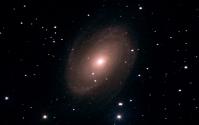Strongly Celestial Looking outward; looking backward in time... |
|||
 |
|||
New! Pictures Gallery Here I will put a half dozen or so of my most recent pictures taken. Some will not be of the highest quality; I just want to show what I've been looking at. The better ones will make their way into the appropriate gallery for longer term. As with all of my galleries, click on the picture itself to bring up a larger, scaleable copy of the picture in a separate window. |
||
Date Taken: 5/13/2013 Equipment: Comments |
||||
Date Taken: 8/8/2012 Equipment: Comments |
||||
Subject: M57 - Ring Nebula Equipment/Exposure Comments |
||||
Subject: M81 - Bode's Galaxy Equipment Comments |
||||
Subject: M92 - Globular Cluster Equipment Comments |
||||
Subject: M39 - Open Cluster Equipment Comments This cluster is approximately 800 light years from earth and is 200-300 million years old. There are at least 30 proven stars in the cluster; note that the defraction spikes in this image were added on purpose to highlight some members. The bright central star in this image has 3.7x more mass than our sun. |
||||
Subject: M27 - Dumbbell Nebula Equipment Comments |
||||
Subject: Orion Nebula (M42) Equipment Comments |
||||